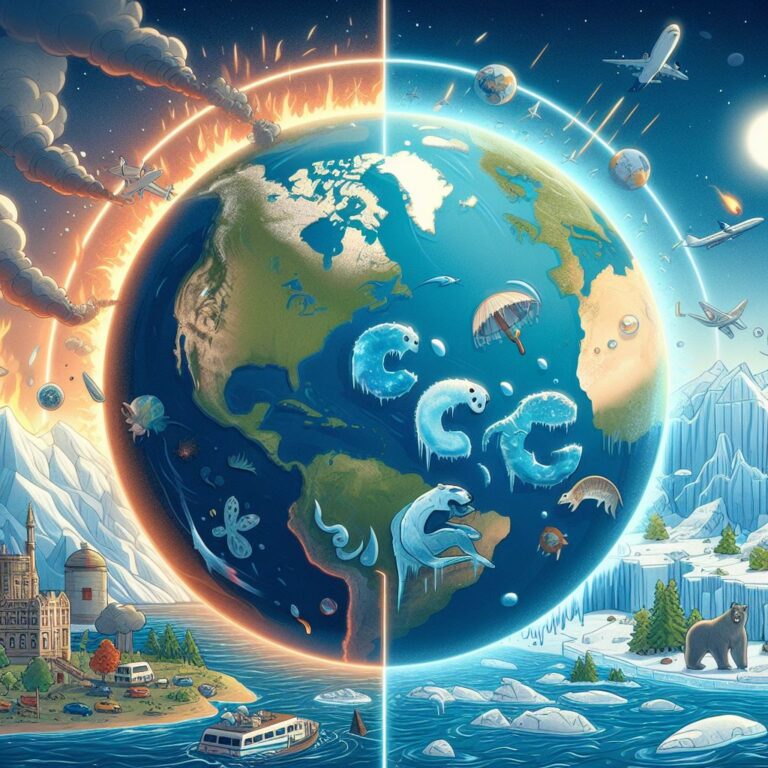In the grand tapestry of Earth’s story, climate change emerges as a pivotal chapter, one that carries profound implications for the planet and all its inhabitants. At its core, climate change is a complex phenomenon driven by human activities, chiefly the burning of fossil fuels and deforestation, which release greenhouse gases into the atmosphere. This leads to a gradual but significant increase in global temperatures, altering weather patterns, melting polar ice caps, and disrupting ecosystems worldwide.
Understanding the Mechanisms of Climate Change
Climate change is fueled by the greenhouse effect, a natural process that regulates Earth’s temperature by trapping heat in the atmosphere. However, human activities have intensified this effect, leading to a surge in greenhouse gas emissions and subsequent global warming. This warming, in turn, triggers a cascade of impacts, from rising sea levels and extreme weather events to shifts in precipitation patterns and disruptions in agriculture.
The Far-reaching Impacts of Climate Change
The consequences of climate change are manifold, touching every corner of the planet and every facet of life. In the Arctic, melting ice threatens the habitats of polar bears and other wildlife, while rising sea levels imperil coastal communities worldwide. In regions prone to drought, such as sub-Saharan Africa, changing precipitation patterns exacerbate food insecurity and trigger conflicts over scarce resources. Like a domino effect, the impacts of climate change reverberate across ecosystems, economies, and societies.
Impact on Daily Life: Navigating the New Normal
Climate change is not just a distant threat looming on the horizon; its effects are already being felt in our daily lives. From the food we eat to the air we breathe, no aspect of modern life is immune to the impacts of a changing climate. Extreme weather events, such as hurricanes, floods, and wildfires, are becoming more frequent and severe, disrupting communities, destroying homes, and claiming lives. These disasters not only cause immediate devastation but also have long-term consequences, from displacement and economic loss to psychological trauma and social upheaval. Like a relentless storm battering the shores of our existence, climate change reshapes the landscape of our daily reality, challenging us to adapt and rebuild in its wake.
Adapting to a Changing World: Resilience and Innovation
In the face of these challenges, communities around the world are rising to the occasion, embracing resilience and innovation to adapt to a changing climate. From implementing green infrastructure and flood-resistant buildings to developing early warning systems and emergency response plans, cities and towns are taking proactive measures to mitigate the impacts of climate change and protect their residents. Individuals are also making changes in their daily lives, from reducing energy consumption and carbon footprints to supporting sustainable practices and advocating for climate action. Like seeds sprouting in the cracks of concrete, these acts of resilience and innovation offer glimpses of hope in the face of adversity, reminding us of our capacity to thrive in a changing world.
Mitigation and Adaptation: Strategies for a Resilient Future
Addressing climate change requires a dual approach: mitigation and adaptation. Mitigation efforts aim to reduce greenhouse gas emissions, transitioning to renewable energy sources, improving energy efficiency, and implementing sustainable land-use practices. Meanwhile, adaptation measures focus on building resilience to the impacts of climate change, such as strengthening infrastructure, enhancing disaster preparedness, and implementing water management strategies.
The Role of Individuals and Communities
While governments and organizations play a crucial role in addressing climate change, individuals and communities also have the power to drive change. From reducing personal carbon footprints by embracing sustainable lifestyles to advocating for policy change and supporting grassroots initiatives, every action counts. Like drops of water forming a mighty river, collective efforts can create waves of change that ripple across society, inspiring others to join the movement towards a more sustainable future.
Despite the urgency of addressing climate change, significant challenges remain, from political inertia and vested interests to the scale of the problem itself. However, amidst these challenges lie opportunities for innovation, collaboration, and collective action. By harnessing the power of technology, science, and social mobilization, we can chart a course towards a more sustainable future, where the health of the planet and the well-being of all its inhabitants are safeguarded.
Conclusion: Towards a Sustainable Future
In conclusion, climate change represents one of the most pressing challenges of our time, demanding urgent and concerted action at all levels of society. By understanding the mechanisms of climate change, embracing mitigation and adaptation strategies, and fostering collective action, we can navigate the complexities of this global crisis and pave the way towards a more resilient and sustainable future for generations to come.
Check out more articles like this at General Archives – Topic In One Article
